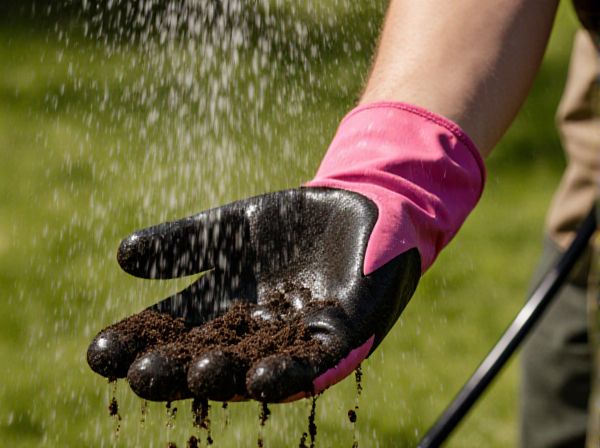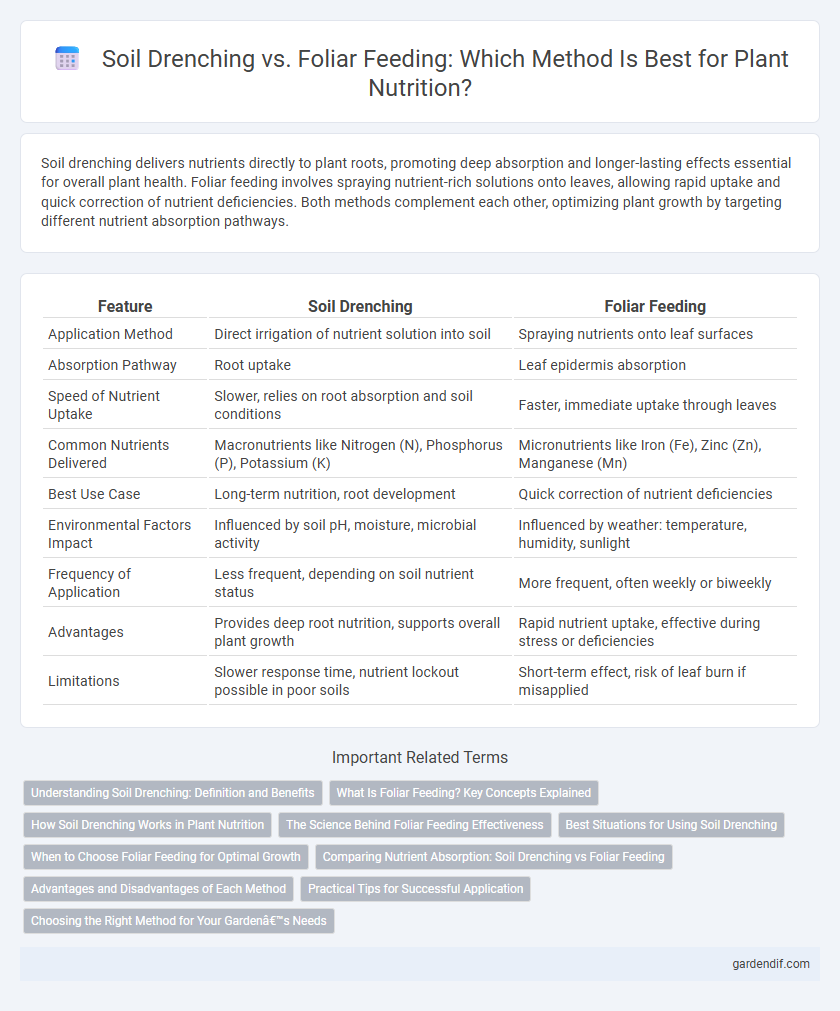
Soil drenching vs Foliar feeding Illustration
Soil drenching delivers nutrients directly to plant roots, promoting deep absorption and longer-lasting effects essential for overall plant health. Foliar feeding involves spraying nutrient-rich solutions onto leaves, allowing rapid uptake and quick correction of nutrient deficiencies. Both methods complement each other, optimizing plant growth by targeting different nutrient absorption pathways.
Table of Comparison
| Feature | Soil Drenching | Foliar Feeding |
|---|---|---|
| Application Method | Direct irrigation of nutrient solution into soil | Spraying nutrients onto leaf surfaces |
| Absorption Pathway | Root uptake | Leaf epidermis absorption |
| Speed of Nutrient Uptake | Slower, relies on root absorption and soil conditions | Faster, immediate uptake through leaves |
| Common Nutrients Delivered | Macronutrients like Nitrogen (N), Phosphorus (P), Potassium (K) | Micronutrients like Iron (Fe), Zinc (Zn), Manganese (Mn) |
| Best Use Case | Long-term nutrition, root development | Quick correction of nutrient deficiencies |
| Environmental Factors Impact | Influenced by soil pH, moisture, microbial activity | Influenced by weather: temperature, humidity, sunlight |
| Frequency of Application | Less frequent, depending on soil nutrient status | More frequent, often weekly or biweekly |
| Advantages | Provides deep root nutrition, supports overall plant growth | Rapid nutrient uptake, effective during stress or deficiencies |
| Limitations | Slower response time, nutrient lockout possible in poor soils | Short-term effect, risk of leaf burn if misapplied |
Understanding Soil Drenching: Definition and Benefits
Soil drenching involves applying liquid fertilizers directly to the soil around a plant's root zone, allowing nutrients to be absorbed efficiently by the roots. This method improves nutrient uptake, enhances root development, and increases soil microbial activity, promoting healthier plant growth. Soil drenching is particularly effective for delivering systemic treatments and ensuring deep nutrient penetration in various soil types.
What Is Foliar Feeding? Key Concepts Explained
Foliar feeding involves applying liquid fertilizer directly onto plant leaves, allowing nutrients to be absorbed through the stomata and epidermis for faster uptake compared to soil drenching. This method targets micronutrients such as iron, magnesium, and zinc, offering precise nutrient delivery during critical growth stages or when root absorption is impaired. Foliar feeding enhances nutrient efficiency, supports plant health, and can correct deficiencies quickly without altering soil chemistry.
How Soil Drenching Works in Plant Nutrition
Soil drenching delivers nutrients directly to the root zone, allowing plants to absorb essential minerals and water efficiently through root hairs. This method enhances nutrient uptake by maintaining consistent moisture levels and promoting microbial activity that helps break down organic matter. Effective soil drenching improves overall plant health by ensuring steady supply of nitrogen, phosphorus, potassium, and micronutrients crucial for growth and development.
The Science Behind Foliar Feeding Effectiveness
Foliar feeding enhances nutrient absorption efficiency by delivering water-soluble fertilizers directly to plant leaves, enabling rapid uptake through stomata and cuticle pores. This targeted method bypasses soil nutrient fixation and microbial activity, ensuring immediate correction of nutrient deficiencies. Studies demonstrate increased photosynthesis and growth rates due to faster nutrient assimilation compared to traditional soil drenching.
Best Situations for Using Soil Drenching
Soil drenching is most effective in situations where plants require deep root nourishment and sustained nutrient absorption, especially during early growth stages or stress recovery. This method enhances microbial activity and improves soil health, making it ideal for potted plants and garden beds with nutrient-deficient or compacted soil. Soil drenching efficiently delivers water-soluble fertilizers or pest control agents directly to the root zone, ensuring prolonged uptake and minimal nutrient loss through evaporation.
When to Choose Foliar Feeding for Optimal Growth
Foliar feeding is most effective during periods of rapid growth or nutrient deficiency when root uptake is limited, such as in compacted or waterlogged soils. Applying micronutrients directly to leaves ensures quicker absorption and immediate correction of deficiencies, especially for elements like iron, zinc, and magnesium. Using foliar feeding during early morning or late afternoon maximizes nutrient uptake while reducing the risk of leaf burn.
Comparing Nutrient Absorption: Soil Drenching vs Foliar Feeding
Soil drenching allows nutrients to be absorbed through the roots, facilitating a gradual and sustained uptake essential for overall plant growth and development. Foliar feeding delivers nutrients directly to the leaves, enabling rapid absorption and quick correction of nutrient deficiencies, especially micronutrients like iron and zinc. While soil drenching supports long-term nutrient availability, foliar feeding offers targeted supplementation, particularly effective during nutrient uptake stress or poor soil conditions.
Advantages and Disadvantages of Each Method
Soil drenching delivers nutrients directly to the root zone, promoting deep root growth and long-lasting nutrient absorption but may lead to nutrient runoff and slower uptake in compacted soils. Foliar feeding provides rapid nutrient absorption through leaves, ideal for correcting deficiencies quickly, yet it is limited by leaf surface area and environmental conditions like rain or high humidity that can reduce effectiveness. Both methods are complementary, with soil drenching supporting sustained growth and foliar feeding offering targeted, immediate nutrient correction.
Practical Tips for Successful Application
Soil drenching involves applying nutrient solutions directly to the soil, ensuring deep root absorption, while foliar feeding delivers nutrients straight to the leaves for rapid uptake. To maximize effectiveness, maintain consistent moisture levels during soil drenching and apply foliar sprays early in the morning or late afternoon to avoid leaf burn and enhance nutrient absorption. Using appropriate concentrations and avoiding application during peak sunlight or extreme temperatures ensures healthy plant growth and nutrient efficiency.
Choosing the Right Method for Your Garden’s Needs
Soil drenching delivers nutrients directly to the root zone, promoting deep absorption and long-term plant health, making it ideal for nutrient-deficient soils or established plants. Foliar feeding provides a rapid nutrient boost by spraying leaves, benefiting plants during stress or when quick correction of deficiencies is needed. Choosing the right method depends on the plant species, growth stage, and specific nutrient requirements to optimize uptake and enhance overall garden productivity.
Soil drenching vs Foliar feeding Infographic

 gardendif.com
gardendif.com